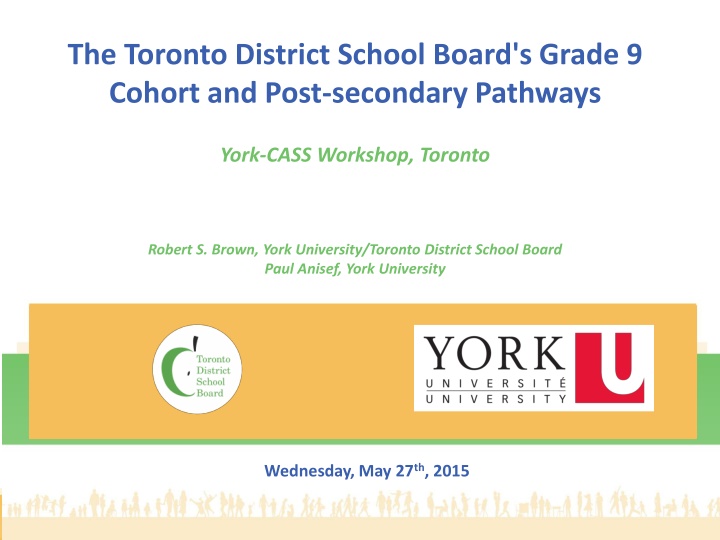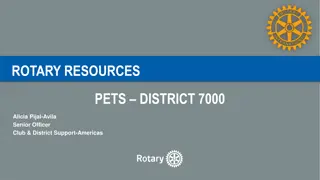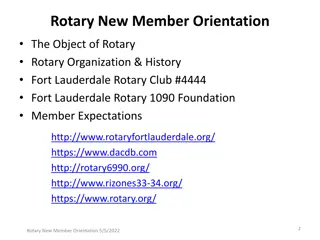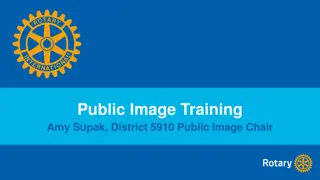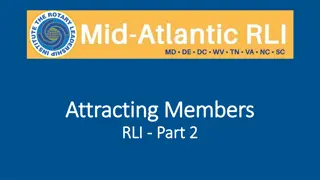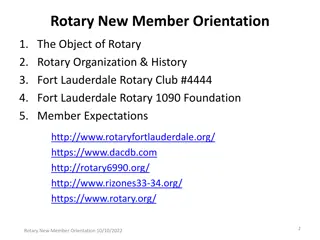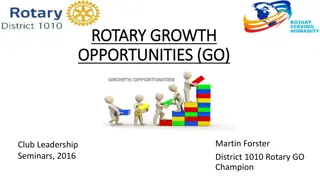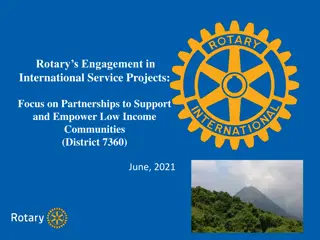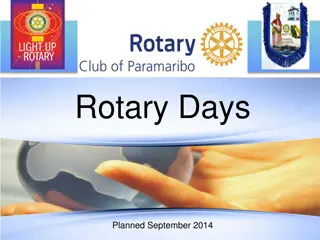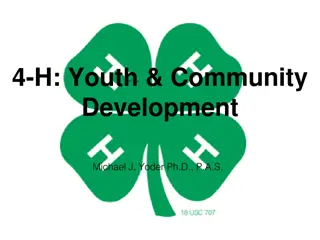Challenges Faced in Rotary Clubs - Act Now for Change
Addressing the declining membership in Rotary clubs over the past decade, this presentation highlights the need for clubs to adapt and evolve. It emphasizes the importance of meeting people where they are and suggests strategies like creating satellite clubs and cause-based clubs to grow sustainably. The slides also point out specific areas with only one Rotary club, indicating potential areas for expansion. Overall, the content urges action and proactive steps to revitalize and strengthen Rotary clubs.
Download Presentation

Please find below an Image/Link to download the presentation.
The content on the website is provided AS IS for your information and personal use only. It may not be sold, licensed, or shared on other websites without obtaining consent from the author.If you encounter any issues during the download, it is possible that the publisher has removed the file from their server.
You are allowed to download the files provided on this website for personal or commercial use, subject to the condition that they are used lawfully. All files are the property of their respective owners.
The content on the website is provided AS IS for your information and personal use only. It may not be sold, licensed, or shared on other websites without obtaining consent from the author.
E N D
Presentation Transcript
The Toronto District School Board's Grade 9 Cohort and Post-secondary Pathways York-CASS Workshop, Toronto Robert S. Brown, York University/Toronto District School Board Paul Anisef, York University Wednesday, May 27th, 2015
The Toronto District School Board (TDSB) Grade 9 Cohort 2006-11 After calculating for exit codes (students who are not in the TDSB), there were 16,365 students starting Grade 9 in 2006. As of October 31, 2011: 12,869 (78.6%) students had graduated; 1,193 (7.3%) were still in the TDSB; and 2,303 (14.1%) had dropped out (that is, according to our records, they had not graduated, were no longer in the TDSB, and had not transferred to another educational institution).
What is the Post-secondary Application Process? Students applying to post-secondary institutions in Ontario provide applications through the Ontario Universities Applications Centre (OUAC) and the Ontario College Application Centre (OCAS). We matched the 2010 applications with information in our Student Information System (SIS) for the 17-21 year old students in the TDSB as of March 31, 2011. We looked at post-secondary applications over the 2010 and 2011 applications cycles (that is, Years 4 and 5 of the cohort). This is not the full picture of post-secondary - many students in the cohort will enter post- secondary in future years, as older adolescents or as adults.
What Characteristics and Challenges Influence this Pattern? Post-secondary Applications Proportion of students 60.00% 47.4% 40.00% 29.1% 13.5% 20.00% 10.0% 0.00% Confirm university in Ontario Confirm college in Ontario Apply to post- secondary Did not apply to post-secondary
Early Development Indicators (Kindergarten) and Post-secondary Pathways This is from a group of students who started two years later than this cohort. It clearly shows that many students who are at risk in Kindergarten do not go to post-secondary. However, most students who do not go to post-secondary are medium or low risk in kindergarten. Source: The 2013-2014 Environmental Scan of the Toronto District School Board, p. 60
Special Education Needs: Grade 6 The vast majority of students without Special Education Needs in Grade 6 graduated (83%) and went to post-secondary (67%). Most students with Special Education Needs (excluding Gifted) now graduate from high school, but do not go to post-secondary (e.g. of students with a Learning Disability, 64% graduated and 35% went to post- secondary. One reason appears to be that students with Special Education Needs do not take Academic courses in Grade 9, which makes it difficult to attend either university or college. Source: The TDSB Grade 9 Cohort 2006-2011: Special Education Needs - Fact Sheet No. 4
Grade 9 Achievement Few students in the Grade 9 Cohort who achieved under 8 credits in Grade 9 confirmed university by the end of five years: 3% of those students with 6 or fewer credits, 13% with 7 credits, 59% with 8 or more credits by the end of Grade 9 confirmed university. Most students who complete 7 credits by the end of Grade 9 will graduate with a high school diploma. The difference between 7 and 8 credits shows the difference between going on to university, and not doing so. Apply to post- secondary in Ontario, but no record of acceptance Confirm university in Ontario Confirm college in Ontario Did not apply to post- secondary Grade 9 Credit Accumulation 2.7% 13.2% 58.6% 8.2% 20.6% 13.8% 4.5% 11.5% 10.9% 84.6% 54.7% 16.8% 6 or fewer credits (high risk) 7 credits (medium risk) 8 or more credits (low risk)
Academic Level, Gender and Age Academic Level: 72.4% of students in Academic courses confirmed an offer of admission to post-secondary (university and college), while only 34.9% of students enrolled in Applied courses confirmed an offer of admission. Slightly more than three-quarters of students taking Locally Developed courses did not apply to post-secondary. Conflict: Applied is supposed to be for students who want to go to college, but most college students took Academic. Gender: 66.2% of female students confirmed an offer of admission to post-secondary, while 55.9% of males confirmed an offer of admission. Age: Grade 9 Cohort students who are a year older are less likely to confirm an offer of admission to post-secondary when compared to age appropriate Grade 9 students (33.1% and 62.1% respectively).
Academic Level, Gender and Age Apply to post- secondary in Ontario, but no record of acceptance Confirm university in Ontario Confirm college in Ontario Did not apply to post-secondary Variable Subgroup Total Academic Applied Locally Developed No Program 11,857 3,573 696 239 61.9% 11.1% 1.3% 2.5% 10.5% 23.8% 16.5% 2.5% 11.1% 8.0% 6.0% 0.8% 16.5% 57.1% 76.1% 94.1% Academic Level Female Male 7,954 8411 52.8% 42.3% 13.4% 13.6% 10.3% 9.7% 23.5% 34.3% Gender 13 14 15 109 69.7% 48.5% 19.6% 3.7% 13.6% 13.5% 11.0% 10.1% 8.2% 15.6% 27.8% 58.7% Age 15,540 716
Racial Groups There is a variation in post-secondary application rates within racial groups. Over 70% of Grade 9 Cohort students who identify themselves as East Asian confirmed an offer of admission to University. This is by far the highest compared to other racial groups. Racial groups that had the highest percentage of confirmed admissions to post-secondary (university and college) included: East Asian, South Asian, and South East Asian (81.9%, 76%, and 68.3% respectively). Racial groups that had the lowest percentage of confirmed admissions to post-secondary included: Latin and Black (38.7% and 41.4% respectively).
Region of Birth Students born in Eastern Asia, South Asia, and Southern and Western Europe have higher percentages of confirmed admission to post-secondary (78.3%, 74.4%, and 70.5% respectively). Students born in English-speaking Caribbean and South and Central America and Mexico have lower percentages of confirmed admissions to post-secondary (29.7% and 45.6% respectively). 57.9% of students born in Canada confirm an offer of admission to post- secondary. This is slightly lower than the overall percentage (60.9%).
Racial Groups and Regions of Birth Apply to post- secondary in Ontario, but no record of acceptance Confirm university in Ontario Confirm college in Ontario Did not apply to post-secondary Variable Subgroup Total White East Asian South Asian Black Mixed Middle Eastern South East Asian Latin Canada Eastern Asia South Asia Western Asia Eastern Europe Central & South America & Mexico English-speaking Caribbean Southeast Asia South and Western Europe Eastern Africa US 4,854 2,778 2,773 1718 825 666 536 292 10,985 1,496 1,374 580 532 45.3% 73.2% 60.3% 24.2% 37.1% 42.6% 47.4% 22.9% 44.2% 71.7% 58.9% 43.1% 56.0% 12.7% 8.7% 15.7% 17.2% 13.5% 19.1% 20.9% 15.8% 13.7% 6.6% 15.5% 16.9% 12.2% 12.3% 7.6% 9.0% 11.4% 10.9% 9.6% 8.4% 10.3% 10.3% 8.0% 9.0% 9.7% 9.6% 29.7% 10.4% 15.0% 47.3% 38.5% 28.7% 23.3% 51.0% 31.7% 13.8% 16.7% 30.3% 22.2% Racial Group 270 23.0% 22.6% 11.5% 43.0% Region of Birth 244 13.9% 15.2% 7.4% 63.5% 213 32.9% 23.0% 13.1% 31.0% 169 60.4% 10.1% 7.7% 21.9% 159 109 39.0% 43.1% 11.9% 13.8% 10.7% 13.8% 38.4% 29.4%
Student Language In general, students speaking English (the largest group, accounting for just under half of the students) have confirmed admission to post-secondary results of 10% below the average (50.6% compared with 60.9%). Students speaking Chinese, Bengali, Tamil, Hindi, and Guajarati have the highest percentages of confirmed admission to post-secondary. Students speaking Spanish and Somali have the lowest percentages of confirmed admission to post-secondary.
Student Language Apply to post-secondary in Ontario, but no record of acceptance Confirm university in Ontario Confirm college in Ontario Did not apply to post-secondary Variable Subgroup Total English Chinese Tamil Urdu Korean Persian (Farsi) Spanish Vietnamese Somali Punjabi Bengali Gujarati Russian Tagalog (Pilipino) Arabic Hindi Greek French Dari Serbian 7,825 2,284 764 500 333 319 317 301 269 255 255 250 248 181 176 149 130 116 114 106 36.5% 72.3% 69.4% 53.2% 64.6% 45.8% 21.1% 60.5% 37.2% 56.1% 70.6% 62.0% 53.6% 28.7% 47.7% 66.4% 47.7% 45.7% 33.3% 70.8% 14.1% 9.3% 9.9% 16.2% 7.8% 17.2% 15.8% 15.9% 9.7% 16.9% 10.6% 16.8% 15.3% 24.9% 16.5% 13.4% 16.2% 5.2% 18.4% 5.7% 11.1% 7.0% 8.6% 9.2% 12.6% 6.9% 9.5% 7.3% 16.0% 11.8% 9.4% 6.4% 9.3% 12.2% 13.1% 8.7% 4.6% 19.8% 12.3% 10.4% 38.3% 11.4% 12.0% 21.4% 15.0% 30.1% 53.6% 16.3% 37.2% 15.3% 9.4% 14.8% 21.8% 34.3% 22.7% 11.4% 31.5% 29.3% 36.0% 13.2% Student Language Did not apply to post- secondary Confirm university in Ontario Confirm college in Ontario Apply to post- secondary Variable Subgroup Total
Parental Presence/Family Structure, Parental Education, and Parental Occupation Parental Presence/Family Structure: Students with both parents at home are more likely to confirm an offer of admission to post-secondary (68.1%), when compared to students living with one parent or other (49.4% and 50% respectively). Parental Education: If parents have attended university, their child is more likely to confirm an offer of admission to post-secondary (72.6%), when compared to students whose parents did not attend university. Parental Occupation: Parents occupation is used as an indicator of family socio-economic status (SES). When comparing students post-secondary application results with their family SES, 73.1% of students with parents in a Professional occupation confirmed an offer of admission to post-secondary. This percentage decreases as students SES decreases with 16.4% fewer students of parents with non-remunerative occupations confirming an offer of admission to post-secondary.
Parental Presence/Family Structure, Parental Education, and Parental Occupation Apply to post- secondary in Ontario, but no record of acceptance Did not apply to post- secondary Confirm university in Ontario Confirm college in Ontario Variable Subgroup Total Both Parents One Parent Other 11,077 2,866 402 54.6% 35.6% 28.6% 13.5% 13.8% 21.4% 10.2% 10.5% 9.7% 21.7% 40.2% 40.3% Parental Presence High School College University Don't Know 2,078 2145 6495 3516 36.8% 43.3% 63.3% 38.2% 15.2% 16.6% 9.3% 18.9% 9.1% 10.0% 11.8% 8.4% 38.9% 30.1% 15.6% 34.5% Parental Education Professional Semi-Professional Skilled Clerical Unskilled Clerical Non-renumerative 2,878 3,328 2,752 1,176 339 65.3% 53.7% 46.1% 37.6% 42.8% 7.8% 12.3% 16.6% 19.3% 13.9% 13.0% 11.1% 9.2% 8.4% 10.9% 13.8% 22.9% 28.0% 34.7% 32.4% Parental Occupation
Sexual Orientation Heterosexual students are more likely to confirm an offer of admission to post-secondary than LGBTQ students (64.1% and 48.7% respectively). Apply to post- secondary in Ontario, but no record of acceptance Confirm university in Ontario Confirm college in Ontario Did not apply to post-secondary Variable Subgroup Total Heterosexual LGBTQ 13,055 288 50.9% 37.2% 13.2% 11.5% 10.2% 12.5% 25.7% 38.9% Sexual Orientation
Next Steps Trajectories of Grade 9 credit failure: Most students who do not pass a key Grade 9 course in Grade 9 (Mathematics, English, Science, Geography) do not go to post-secondary. Why is this? Extending the analysis of this cohort from October 31, 2011 to October 31, 2014: This provides the full picture of the direct transition from secondary to post-secondary. Follow former TDSB students through college (including adults). Analysis using the prism of Intersectionality, e.g. race plus gender plus income (see attached Fact Sheet). The Gateway Cities project: comparing results of key Gateway cities including Toronto, Chicago, Vancouver, Dallas-Fort Worth, and London UK.
